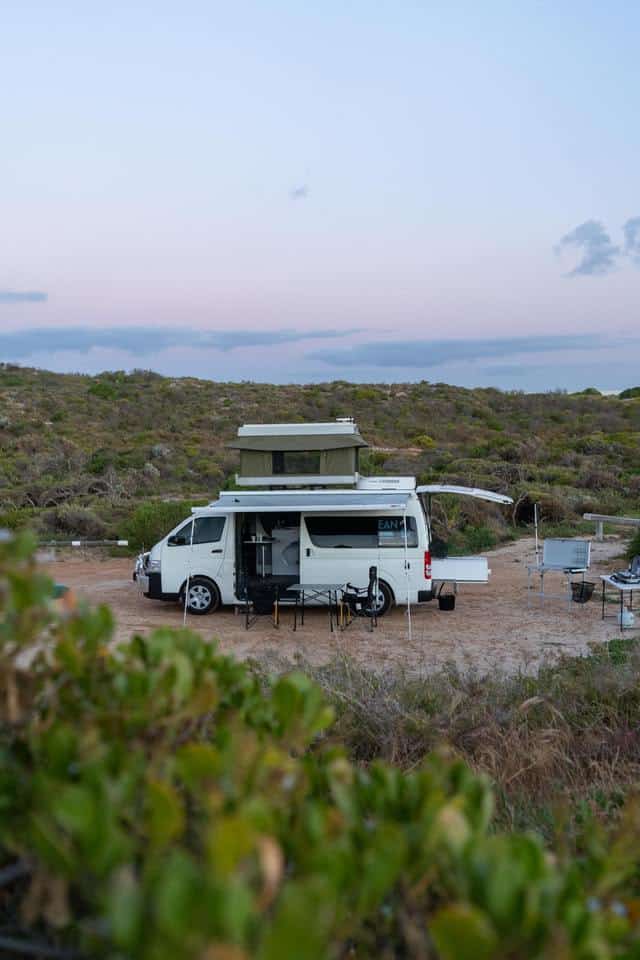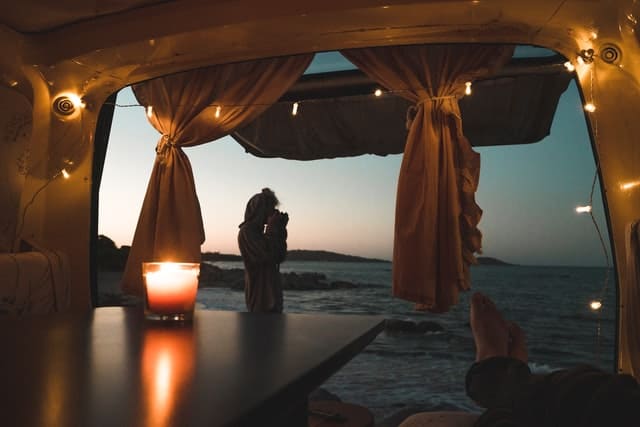You’re in the market for an RV or a motorhome but don’t know where to start? Do you go all out and invest in a luxurious home-on-wheels in the form of a Class A RV or a truck-style Class C RV with an over-cab bunk or storage space above the cab of the truck? If these don’t take your fancy, then a Class B RV might just be the answer to your travel needs.
What is a Class B RV?
A Class B RV or motorhome is the smallest of the three types of motorhomes and is built using an automotive van chassis. Also known fondly as a campervan, these compact RVs provide a comfortable travel experience without the intimidating size of a full-sized motorcoach.
Small, streamlined, and ready to roll, Class B motorhomes are more fuel-efficient than Class C motorhomes and provide a neat and cozy living space for couples or small groups of friends. Due to their size, they can also double as an everyday driving vehicle.
Sleek and modern, Class B motorhomes utilize every square inch of interior space and are packed with all the amenities needed for comfortable camping such as a full kitchen, flush toilet, and shower, overhead air-conditioning, power inverter, TV, and entertainment center, as well many offer an auxiliary generator for extended off-the-grid camping.
Sleek and modern, Class B motorhomes utilize every square inch of interior space and are packed with all the amenities needed for comfortable camping.
How Long Are Class B RVs?
Class B RVs range between 15 and 20 feet in length. While this may seem small, campervans are specifically designed to make the most of every square inch and they are packed with all the amenities needed for camping from full galley kitchens and beds to flushing toilets and showers.
Pros and Cons of a Class B RV
We weighed up the pros and cons of Class B RVs.
Pros
- Drivability – Class B RVs drive like regular vehicles
- Easy to park and maneuver
- Comfortable to drive
- Small enough for everyday use
- Easy to store
- Super features, like solar prep, lithium batteries, premium sound systems, continuous water heaters
- More space for bike/kayak racks
- Tow capacity
- Easy campsite selection
Cons
- Limited space
- Limited floor plans
- Less storage
- Destination exploration
- Smaller tanks
- Lack of dedicated beds
Campervans are easy to drive, easy to park, and are packed with great features for comfortable camping. Mazda E2000 LWB campervan by Nachoman-au / WikiCommons / CC BY-SA 3.0.
Best Class B RV
We hit the road in some Class B RVs and came up with a list of our top picks for heading out into the great wide yonder with all the creature comforts of home.
Best Overall: Thor Motor Coach Sequence
The Thor Motor Coach Sequence is a super, cost-effective camper van with standout features that is easy to drive and very comfortable to live in. Built on a gas-powered RAM Promaster® 3500 van chassis, the Thor Motor Coach Sequence is powered by a fuel-efficient V-6 engine, has a front-wheel-drive platform and a 36-foot turning diameter. It also has a towing capacity of 3,500 pounds.
Measuring 21 feet in length, the spacious interior is comfortable and stylish with residential vinyl flooring, dander and scratch-resistant sofas, TecnoForm® Euro-style cabinets, LED lighting, and plenty of storage space.
The kitchen is packed with all the features you need to create culinary magic, including a stainless steel sink with covers, a two-burner gas cooktop with lighting above, a 12-volt electric fridge, solid surface kitchen countertops, a pull-out countertop extension, a pop-up outlet, and a convection microwave.
The Thor Motor Coach Sequence features a Pop-Top SkyBunk® sleeping area with a 200-watt solar panel and a fully-enclosed wet bath with a sink, a deluxe shower curtain, and plenty of storage.
Additional extras include a Thule bike rack that can carry two full-sized adult bikes; an extendable Thule roof ladder with an innovative magnetic support system to access the roof of the campervan, and a Thule patio awning with supporting legs and aluminum gussets that are easily rolled in and out with a press of a button.
Pros
- Larger than most camper vans
- Extremely affordable
- Impressive features
Cons
- Average warranty length
Best for Dry Camping: Roadtrek Zion
The Roadtrek Zion focuses on the former and is built for comfortable camping with plenty of space for extras like bicycles, kayaks, and tents. Built on the Ram ProMaster chassis, this versatile campervan boasts an open concept floor plan that allows for extra gear to be packed in the spacious center aisle.
The 21-foot campervan has a beautifully designed interior with a spacious galley, a comfortable sofa and bed, a full bathroom, and an abundance of storage space. Large windows flood the interior with light and an 11,000 BTU roof-mounted air conditioner keeps the interior cool in the summer.
Additional features include a retractable power awning for shade, an outdoor shower, a heavy-duty, magnetic bug screen for the rear and passenger sliding door, power steps, folding side mirrors for tight spaces, and environmentally-friendly solar panels.
Pros
- Ideal for outdoor adventurers
- An impressive amount of storage space
- Good warranty
Cons
- Limited space
The Roadtrek Zion focuses on the former and is built for comfortable camping with plenty of space for extras like bicycles, kayaks, and tents.
Best for the Campervan Life: Pleasure-Way Plateau
The luxurious Pleasure-Way Plateau is a 23-foot campervan that is ideal for travelers with a wanderlust for adventure. Built on a Mercedes-Benz Sprinter chassis, this amazing van is packed with an array of amenities and features from a sophisticated power system and heating system and a 2,000-watt inverter to premium cabinetry and countertops and swivel chairs.
The spacious interior features an inflatable air bed fitted for the cab, MCD blackout roller shades, and folding privacy/sunshades for all the windows. Vinyl flooring, a vinyl soft-touch headliner, microfiber suede upholstery on the rear walls, and recessed LED lighting under the cabinets and along the roof create a cozy and warm ambiance.
A fully equipped galley kitchen features a convection microwave oven, a three-way refrigerator/freezer, a burner stove, a large under-mount stainless steel sink with a Corian® cover, a solid surface countertop, and Baltic birch drawer boxes. A private enclosed wet bath features a shower, stainless steel sink, residential-style ceramic bowl toilet with a foot flush, and a medicine cabinet and vanity with a mirror.
State-of-the-art technology in the van includes a Bose® soundbar w/ Bluetooth®, a rear 24” Smart LED TV with a swing-out mount, a Blu-ray™ player, and multiple USB charging ports.
Pros
- Comfortable and spacious layout
- Amazing features
- Exceptional warranty coverage
Cons
- Limited space
- Expensive
Best Value for Money: Winnebago Solis
Rated among the best Class B RVs, the Winnebago Solis is a fantastic investment that is packed with great features and promises a comfortable home-away-from-home from which to live while on the road. Well-equipped for backcountry adventures and extended-season camping, the Solis boasts a flexible interior, plenty of storage, and can comfortably sleep four adults.
Despite its smaller size, the Winnebago Solis is designed in a way that it features an array of superb features for optimal comforts, such as the pop-up top, a stylish dinette, a smartly designed water system, and cassette toilet, and a Murphy bed.
The van features a kitchenette with a sink, stovetop, an added slide-out countertop space, and plenty of overhead shelving for storage. There is a bathroom with a shower and toilet, and the back of the van is converted into a sleeping area with additional sleeping space in the pop-up top.
Pros
- Sleeps four people
- Packed with great features
- Efficient use of space
Cons
- Below-average warranty protection
- Craftsmanship issues
A perfect evening after a day of exploring.
Best Build Quality: Coachmen Galleria
The Coachmen Galleria is one of the largest campervans on the market and comes with a hefty price tag but packs a punch when it comes to luxury camping. Built on the chassis of the award-winning 3500 Mercedes-Benz Sprinter, the Coachmen Galleria is 24 feet long with a 5,000-pound tow hitch and is powered by a fuel-efficient turbo-diesel Mercedes BlueTEC® engine.
The campervan is available in four designs and uses premium components like the Truma Combi furnace/water heater system, Onan generator, and locally crafted maple cabinetry. Other top features include WiFiRanger SkyPro, 30 Amp SMART plugs, a 24” LED Smart TV, Q-Foam in sofas and jump seats, a Nova Kool 7300 refrigerator, and motion sensor lighting and composite cabinet backing in the overhead cabinets.
An Onan QG 2500 LP generator is very quiet and three 110-watt solar panels provide environmentally-friendly power for appliances. The interior is kept cool with a Turbo II 12 volt air conditioner and there are multiple USB ports in the main living area of the campervan.
Pros
- Environmentally-friendly
- Fuel efficient
- Very quiet generator
- Solar panels for eco-friendly energy
Cons
- Very expensive
- Below-average warranty protection
Best for Adventure: Antero Adventure Motors Longs Peak
The Longs Peak Adventure Campervan by Antero Adventure Motors is the ideal van for adventurers and camping enthusiasts. Built on a Mercedes Sprinter chassis, this van is durable and reliable and designed to make the most use of the space available.
The Longs Peak Adventure Campervan is packed with first-class features to make your camping experiences unforgettable. The “O.G.” Off-Grid Power System is a power package boasting 210-amp hours of Lithium-Ion battery storage, 180 watts of rooftop solar, a 2000-watt inverter, and multiple outlets in strategic places all over the van.
The Smart Floor System boasts full-length L-track insects that allow you to configure the seating and accessories several ways and the DayDreamer Multi-function Bed quickly converts from a sleeping area to an eating dinette or becomes a workspace.
Other features include upgraded off-road wheels and tires, side steps, LED sidelights, a roof rack system and roof vent, a rear bumper step, vented side windows, bug screens, and privacy screens, an external shower station port, an on-board air compressor, and a powered awning.
Pros
- Designed for maximizing space
- Solar panels for eco-friendly energy
- Off-Grid Power System
Cons
- Expensive
Top Pick: Winnebago® 4×4 Revel™
The Winnebago® 4×4 Revel™ is another top pick for adventurers with a function-fueled design and off-road capabilities. Built on the Mercedes-Benz® Sprinter chassis and powered by a three-liter turbo diesel engine, the Revel includes low-range electronic stability and traction control, as well as adaptive cruise control, four-wheel ABS, lane-keeping assist, and active brake assist.
The interior of the Winnebago® 4×4 Revel™ boasts a pull-up dinette table, a Flex bed, an all-in-one gear closet, and a wet bath with a shower and toilet. LED ceiling lights and a soft-vinyl ceiling give the campervan a warm, homely ambiance, while ABS plastic wall coverings make it easy to clean.
Other top features of this campervan include a 200-watt solar panel and 2,000-watt power inverter, a power lift bed that can be raised to use the 140-cubic-foot gear garage for additional storage, and a metal roof rack for gear, bikes, and kayaks.
Pros
- Designed for maximizing space
- Solar panels for eco-friendly energy
- Off-Grid Power System
Cons
- Expensive
Frequently Asked Questions
Do I need a special license to drive a motorhome?
It is best to double-check the rules of the road for whatever state or country you are planning on traveling through, however, typically, you will not need any type of special driver’s license to drive a motorhome.
What is the difference between a class A, B, and C RV or motorhome?
A class A motorhome is built on a large bus or truck chassis. They are the bigger motorhomes and generally, you will find features like air ride suspension and breaks on these. A class B motorhome is essentially a van with a living area in the back. Class C is built on a truck chassis with added area in the back, and an overhead bunk above the cab.
What is the best speed limit to stick to on the highway?
A motorhome is classified as a non-commercial vehicle, so can follow all normal car speed limits. Bear in mind that the faster you go, the less control you will have of the vehicle and the less mileage you will get out of the tank. The best gas mileage will be found at around 55 to 60 mph. Always err on the side of caution when driving a motorhome.
Do I need to get my RV weighed at weigh stations?
Weigh stations are only for commercial vehicles that are hauling commercial loads, so you don’t have to weigh your motorhome at a weigh station.
Which is better – diesel or gas?
The answer to this question will depend entirely on what you plan on using your RV for. If you plan on taking long trips around the country, or if storage space is a major concern, diesel is your best option as it is more fuel-efficient than gas. If you plan to just use your rig during the summer for short trips and then store it in the winter, the better way to go is gas.
Can I use my RV in the winter?
Most definitely! Many motorhomes come fully equipped for cold weather with features like heated holding tanks and water lines, enclosed underbellies, added insulation, and large furnaces.
Do passengers need to wear a seat belt in the back of the motorhome?
It is always recommended that any passenger in any vehicle wear a seat belt. Seat belts are life-saving devices and should always be worn whether the law stipulates it or not. Once again, it is best to double-check the rules of the road for whatever state or country you are planning on traveling through on whether there are different rules.
What is the difference between the chassis and house battery?
Both of these batteries are lead-acid batteries. This means that they are composed of lead plates and sulfuric acid. The chassis battery is meant for a quick strong punch of current to get the engine started. This is the same as a car battery. The house battery is what they call a deep cycle battery. These are meant for a lower current for longer periods. This battery is what will power your lights, appliances, etc.
Can I deduct any part of my motorhome from my taxes?
Yes! A motorhome can be considered a second dwelling! If you finance your motorhome, you can write off the interest on your payment. You can also write off the taxes paid on the initial purchase, as well as the cost to register and renew your plates each year (https://www.mhs2go.com/).
Happy camping!


Jill Miller is the founder of Your RV Lifestyle. Trading corporate America for the open road, Jill, along with her partner Jose, began their RV journey, making an unconventional start by wintering in New Jersey. A natural adventurer, she was motivated by a desire to explore the USA and beyond, embracing the varied landscapes, communities, and cultures across the country.
For Jill, the allure of RV living was not about material accumulation, but rather the pursuit of an adventurous, fulfilling lifestyle. A lover of golf, bicycling, hiking, and line dancing, she has carried her passions across the country, engaging with them in diverse settings. Jill’s commitment to the RV lifestyle came after years of careful research, numerous consultations with RV owners, and personal trials, including living in a rental RV.




